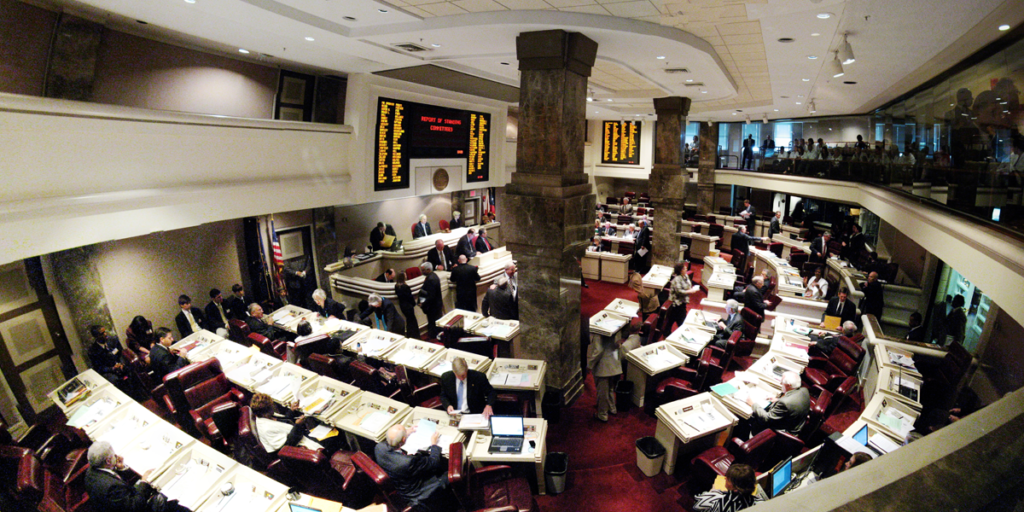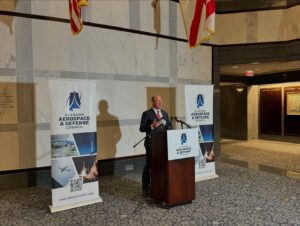Jared Taylor, white nationalist invited to University of Alabama

Jared Taylor, a self identified white nationalist has been invited by a student group to speak at the University of Alabama. Taylor was invited to speak on April 19 by Students for America First; a student organization at the University “dedicated to the recognition & preservation of the American ideals of self-determination, individual liberty, and constitutionally-bound democratic government as absolute necessities for prosperity.” According to the Southern Poverty Law Center, Taylor is “the founder of the New Century Foundation and edited its now discontinued American Renaissance magazine, which, despite its pseudo-academic polish, regularly publishes proponents of eugenics and blatant anti-black and anti-Latino racists.” Stuart Bell, the University’s President sent an e-mail to staff and faculty members, stating that “This ideology is counter to our institutional values. The University of Alabama did not invite this individual. UA stands for the quality of all people,” according to AL.com. “Many in the campus community, including campus leadership, have strong feelings against the messages this person may espouse. The security of our campus is our absolute priority. Hate and bigotry have no place at The University of Alabama. Our community is diverse, inclusive and accepting, and we are committed to treating one another respectfully. We value the ways diversity enriches our University community.”
$400k ad buy highlights state’s dismal infrastructure due to wasteful spending

On Thursday, Conservatives for Better Leadership (CBL) announced a nearly $400,000 TV, radio and digital advertising campaign educating residents statewide about the waste of critical tax dollars needed for infrastructure projects in Central and Northern Alabama being spent instead on pet projects along the Gulf Coast. According to the groups press release, “you don’t have to drive far to see our states infrastructure is in complete disrepair and not ready for the booming economic growth that the families and businesses of our state are ready for. It’s time we do something about it. With over 1,200 of our bridges deemed structurally deficient and thousands of miles of roads that are congested and unsafe, our leaders should be embarrassed to spend a single dollar on projects that aren’t 100% necessary. We are counting on our leaders to finally commit to prioritizing needed infrastructure improvements rather than shoveling our tax dollars to the politically connected.” After years of ballooning costs and excessive spending, ALDOT Director John Cooper, a Robert Bentley appointee, continues to oversee his department without any notion of prioritization or accountability. CBL is encouraging taxpayers statewide to join our call for Governor Kay Ivey to keep her promise to breathe new life into the corrupt way things have been handled in Montgomery and prioritize spending on justifiable projects rather than wasteful and unnecessary ones such as this one. Take a look at the statewide ad below where one Alabama mom expresses her concerns about how there are 600 bridges unable to carry her children to school, yet ALDOT is spending $30 million on a new bridge to the beach. Watch the ad below:
Lawmakers end session with tensions, eye on elections

Alabama lawmakers had vowed to steer clear of controversy this legislative session. They found it anyway. Lawmakers adjourned the 2018 session Thursday afternoon following last-minute disputes over an ethics law exemption and the demise of an anti-racial profiling bill. The House of Representatives spent much of Thursday in debate over the bill to exempt the economic developers from the state ethics law. African-American lawmakers said they were upset that they learned from media reports that the profiling bill would not get a vote on the session’s final day. The bill would have required law enforcement officers to record the reason for traffic stops and the race of the motorists Lawmakers leave Montgomery for the campaign trail. All 140 legislative seats are up for election in 2018. Republished with the permission of the Associated Press.
Bill to track race at traffic stops dies in Alabama Legislature

Alabama lawmakers moved to end the legislative session without a final vote on a bill to collect data on race and traffic stops. House Speaker Mac McCutcheon said Thursday the bill would not get a vote on what will be the last day of the session. African-American lawmakers named the bill a priority. It stalled in the House after being unanimously approved by the Senate. Sen. Rodger Smitherman, the Democratic bill’s sponsor, said he was insulted that McCutcheon told the media the bill was dead for the session, but didn’t tell him. Smitherman said all he wanted was a vote. The Alabama Senate on Thursday passed the education budget and then voted to end the session. While the Senate adjourned through the session, House members continued to meet through mid-morning. Republished with the permission of the Associated Press.
Final passage given to close loophole in state’s drunk driving law

Alabama lawmakers in the State House voted on Thursday to close a loophole in the state’s drunk driving law in hopes of reducing drunk driving deaths. The law received final passage from the house on the last day of session with a 78-14 vote for the bill. It now moves to the governor to be signed into law. SB1, sponsored by Springville-Republican state Sen. Jim McClendon would require persons charged with driving under the influence to use an ignition interlock device after their first offense. An ignition interlock is a device about the size of a cell phone that is wired into the ignition system of a vehicle. A convicted drunk driver must blow into the device in order to start their vehicle. If they have a measurable amount of alcohol in their system, it prevents the vehicle from starting. In 2014, Alabama became the 21st state to pass an all-offender ignition interlock law, expanding the use of ignition interlocks to all convicted drunk drivers, including first-time convicted drunk drivers with an illegal BAC of .08 or greater. However, loopholes exist that allow first-time offenders to enter into diversion agreements or choose not to go on the interlock. SB1 closes that loophole and incentivizes more people to choose an interlock over choosing to drive illegally on a suspended license. According to Mothers Against Drunk Driving (MADD) the Yellowhammer State reduced drunk driving fatalities by 6.8 percent from 2014 to 2015 thanks to use of the device.
Edward Bowser accepts position with Randall Woodfin administration

Former AL.com employee and current Content Creator at Big Communications, Edward Bowser on Thursday took to social media to announce that he has accepted a position with Birmingham Mayor Randall Woodfin‘s administration. He will be working on the Mayor’s mayor’s public information team in order to provide greater transparency regarding initiatives coming out of City Hall and into the Birmingham community. Bowser posted the news on Facebook that he “had planned to share the news over the weekend but since my DMs are poppin and my texts are blowing up I figured I’d break the news here and now.” Bowser posted: I’m honored to announce that I’ve accepted a position with Mayor Randall Woodfin’s administration – starting Monday I’ll be joining the mayor’s public information team. My goal will be to provide greater transparency regarding initiatives coming out of city hall and into our communities. It’s no secret that I’m very passionate about pushing our city forward and ensuring that all of us – from the smallest to the largest of our 99 communities – has a voice. I’m here to be that bullhorn. Thanks to Mayor Woodfin for trusting me with this very crucial role and thanks to all of you for the years of support and encouragement. We all have the same goal, a better Birmingham. I’m grateful to help make that a reality.
Daniel Sutter: Driverless cars and public transit

The first driverless car pedestrian fatality occurred recently in Arizona, almost two years after the first fatal crash. These tragic fatalities signal the ongoing development of this technology. Cars and trucks with drivers killed 5,800 pedestrians in 2016, so a driverless car pedestrian fatality was probably inevitable. Driverless cars will reshape our economy, as 2.8 million people currently work in transportation. One area of disruption which has flown under the radar is public transportation. A new Cato Institute study, “The Coming Transit Apocalypse,” highlights the looming wreck. How can we be sure that driverless vehicles will be on the road soon? Nothing is certain in life, but the Cato study notes that more than three dozen companies worldwide are experimenting with the technology, including auto makers, auto parts suppliers, and tech companies. Thus many companies believe that practical self-driving vehicles are within reach. Given that these companies are trying different approaches, it seems likely that at least one successful design will emerge. Public transportation is already hemorrhaging riders, with a 3 percent decline in the first half of 2017 following a 4.4 percent decline between 2014 and 2016. Seven metro transit systems have seen ridership declines of at least 27 percent since 2009. Although lower gas prices partly explain this, ride sharing services like Uber and Lyft are also having an impact. Ride sharing offers greater convenience than transit with door-to-door, on-demand service, but is currently more expensive. Driverless, shared vehicles are projected to be price competitive with transit. Consequently, the Cato study contends that public transit will be “extinct” everywhere outside of New York City and perhaps a couple of other markets by 2030. Mass transit has never been very popular since the widespread ownership of cars, and currently carries less than one percent of travelers in all but a few cities. One disadvantage of mass transit is geography: residents and jobs are too spread out in most American cities to generate high enough demand for either buses or trains on centralized routes. Culture also plays a factor, as many Americans simply prefer driving. Low ridership rates are not due to a lack of government spending, which has exceeded $1 trillion (adjusted for inflation) since 1970. Fares cover only about 30 percent of expenditures. Americans will not use even highly subsidized public transport. Many transit agencies have deferred maintenance on rail systems, which have a useful life of about 30 years before requiring substantial rebuilding. Washington’s Metro system turned 30 in 2006, and by 2013, incidents of smoke in tunnels were causing evacuations twice a month. Unreliable service makes transit less competitive with ride sharing going forward. An end of public transport, however, will not end taxpayers’ costs. Many systems went into debt building or repairing subway or rail lines, while others have significant unfunded health care and pension liabilities. For example, the Cato study estimates that Boston’s transit system has $3.4 billion in unfunded liabilities, which represent a portion of employees’ compensation. Transit systems have spent lavishly on new rail lines instead of ensuring that promises to employees will be kept. Regardless of exactly how quickly self-driving cars take over, further investments in transit infrastructure do seem dubious at this time. Nonetheless, Los Angeles County decided in 2016 to spend $120 billion, primarily on new light rail lines. The Cato study suggests that new rail lines being planned now will be obsolete before finished. Only government agencies spending our tax dollars can afford to be so short-sighted. The potential transit apocalypse illustrates a recurrent problem. Once political support for spending coalesces, government finds adjusting to changing economic and societal conditions difficult. Mounting losses do not cause proponents to sour on mass transit. Economist Mancur Olson claimed that the entrenchment of programs under democracy produced stagnation. Public transportation has helped many Americans, particularly those who could not afford cars. Changing conditions, however, require policy changes. I fear that we will still be building subways even after everyone has their own automated chauffer. ••• Daniel Sutter is the Charles G. Koch Professor of Economics with the Manuel H. Johnson Center for Political Economy at Troy University and host of Econversations on TrojanVision. The opinions expressed in this column are the author’s and do not necessarily reflect the views of Troy University.
Education Trust Fund Budget clears final hurdle, heads to Kay Ivey’s desk

After a day of very few accomplishments, the Alabama State Senate returned Thursday morning to give final approval to the Education Trust Fund Budget. The $6.6 billion education budget for Fiscal Year 2019, which starts October 1 is the largest education budget for Alabama’s schools since the great recession of 2008. It expands funding for our First-Class Pre-K program, higher education and among other initiatives The State House approved the budget 98-0 on Tuesday. It now moves to Gov. Kay Ivey’s desk for approval. Ivey has already commended the measure’s passage and is expected to sign HB175 without hesitation. “I am proud to have put forward an Education Trust Fund Budget which represents the largest investment in education in a decade,” said Ivey. “As I have prioritized education, it makes me proud to see that this budget expands funding for our First-Class Pre-K program, higher education and other important initiatives. I appreciate the work of Budget Chairs Senator Arthur Orr and Representative Bill Poole in shepherding the budget and for joining with me in positively impacting education for all of Alabama’s children.” Ivey concluded, “To invest in education is to invest in our future, and I look forward to cementing that investment by signing this exceptional budget into law.”
Incentives bill to encourage rural broadband expansion becomes state law

In Alabama, there are more than 842,000 people without access to a wired connection capable of 25mbps download speeds. Over 1 million people in Alabama have access to only one wired provider and another 276,000 people in Alabama don’t have any wired internet providers available where they live. A new law hopes to change all of that by incentivizing the expasion of broadband across rural Alabama. On Wednesday, Gov. Kay Ivey signed SB149, the Alabama Broadband Accessibility Act, which authorizing the creation of a broadband accessibility grant program to be administered by the Alabama Department of Economic and Community Affairs (ADECA). The bill, sponsored by Guntersville-Republican State Sen. Clay Scofield and Geneva-Republican State Representative Donnie Chesteen, also creates the Alabama Broadband Accessibility Fund. “The internet is vital to economic development, health, education, and to be honest, all areas of our modern life. This common sense legislation will help us attract new broadband to areas that need it most, especially in rural Alabama,” said Ivey. “I congratulate Senator Scofield and Representative Chesteen for a job well done in seeing this bill through the legislature. It is just another step forward as we improve access to high-speed internet sooner rather than later.” It’s safe to say — the third time is a charm. The 2018 session was the third time Scofield introduced the bill this quadrennium. “As a senator and a resident of a rural part of Alabama, I understand the need for broadband expansion across our state. With this expansion we can see more growth in our economy, our residents can find better health care and there will be more opportunity for our students to learn,” emphasized Scofield. “I appreciate Governor Ivey for fully supporting our efforts to improve life in rural Alabama.” “I was proud to carry this important legislation in the House of Representatives,” added Chesteen. “As a representative of the citizens of rural Alabama, I see first-hand how a lack of internet connectivity limits the growth of communities. It is important that we get this new program up and going so that our rural communities will be able to take part in the economic growth that our larger areas are seeing,” Through this legislation Alabama encourages accelerated private investment in broadband infrastructure by telecommunications companies, cable companies and electric cooperatives in rural areas. Grants awarded by ADECA under this act may only be awarded for projects in unserved areas. “The Alabama Broadband Accessibility Act gives the state a valuable new tool. With Governor Ivey’s support, ADECA will work under this new grant framework to facilitate the expansion of broadband in rural areas of Alabama that currently lack high-speed internet,” added ADECA Director Kenneth Boswell. Alabama will further be helped by a pilot program, grants and loans from the federal government. Last week, Congress, through an effort led by Alabama Congressman Robert Aderholt, included in the $1.3 trillion omnibus spending bill a $600 million Broadband Pilot Program, created by the Secretary of Agriculture, which will enable applicants to finance a project by combining loans and grants to provide broadband to eligible rural and tribal areas. “This new federal pilot program will help boost broadband expansion in Alabama and around the country. It is a testament to the Trump Administration’s commitment to improving the lives of rural America,” Ivey explained. “I thank Congressman Aderholt for leading the charge on this effort. In Alabama, we plan to take advantage of every opportunity that is provided us, in order to ensure every Alabama citizen has proper access to this vital aspect of our modern-day infrastructure.” The newly created federal investment will leverage nearly $1 billion in total new rural broadband projects across the country.
University of Alabama instructor works to prevent injuries in young athletes

Dr. Lizzie Hibberd’s goal for the University of Alabama’s Athletic Training Research Lab is that it have an impact in the real world. “Every step is about building relationships with people — the athletes, athletic trainers, the parents — so they understand that you’re there to improve their health care,” she says. ”I’m trying to build relationships with people to become part of the community so the research has more impact.” Hibberd, who came to the University of Alabama in 2014, completed her bachelor’s and master’s degrees in athletic training at the University of North Carolina at Chapel Hill. While a graduate student, she was an athletic trainer for the swimming and diving teams there. “One of the big pushes in health care is evidence-based practice, so [I wondered] what does the literature say? But when I went to the literature for answers to my questions on how to treat athletes better, I couldn’t find the answers. That’s when I set out to help create that evidence,” Hibberd says. She decided to get her doctorate, also from UNC-Chapel Hill, in human movement science, with a focus on shoulder injury biomechanics. During that time, she became interested in youth athletes. While working with college athletes, she noticed that many who came to see her “were broken.” They had developed bad adaptations from participating in sports for years, and she wanted to know what intervention might have prevented those problems. “I’ve been putting more emphasis on finding characteristics in youth athletes and how those relate to injuries. When do they develop certain physical characteristics? How does their participation in training influence those characteristics, and how and when can we intervene?” A lab that’s ready to move The Athletic Training Research Lab, which Hibberd created soon after arriving at UA, specializes in clinical outcomes research with the goal of improving athletic performance while decreasing the risk of injury in athletes of all ages. The lab is equipped with high-speed video cameras; GoPro cameras; dynamometers, which enable researchers to determine a strength test number; inclinometers, which measure angles and range of motion; therapeutic exercise equipment, and more. The largest piece of equipment is a diagnostic ultrasound that Hibberd uses to look at muscles and bones and get a snapshot of the inside of the body. “In setting up the lab, it was important that all the equipment be portable,” she says. “The work is a lot easier if you can take your equipment to a field rather than bringing the whole team into the lab. In order for research to be clinically applicable, someone has to have those tools both in the clinic and on the field.” The lab is also a great opportunity for students to engage in research. Hibberd’s students are writing papers and carrying out projects that range from concussions in hockey players to lower extremity injury prediction. “I show them the tools and equipment we have, and, with what they know and their interests, they come up with their own research projects,” Hibberd says. One student’s project looked at different shoulder characteristics of the members of UA’s wheelchair basketball team and how those characteristics have been shown to relate to injury. They then implemented a six-week intervention program that could potentially prevent injury in that population. In another example, a doctoral student looked at tracking recovery after someone exercises. The project focused on how to evaluate recovery and determine when the muscles are ready for exercise again. Preseason screenings for Little League players With her interest in youth athletes, Hibberd hopes to start a project with the Tuscaloosa County Park and Recreation Authority to assess characteristics of Little League baseball players before they start pitching and how those characteristics might predispose them to injury. “Often, dads will coach their children’s baseball teams … but they’re trying to teach kids how to throw a baseball,” she says. “They don’t know about teaching skill acquisition relative to fundamental physical characteristics, such as how to squat or balance or do a lunge. That’s not part of their skill set or thought process. But if no one teaches that to the kids, they figure it out on their own, often incorrectly, which can predispose them to injury.” Hibberd’s goal is to provide preseason screenings to youth athletes, identify intervention programs that will help prevent injury, and track the effectiveness of the programs. Ultimately, she hopes the interventions will become standard practice in community leagues. “As a researcher, your success is based on whether the end user is applying your work,” she says. “It’s not about doing the research or getting published. It’s about applying the findings into the community and getting somebody to do it. I want to be able to provide screenings and positively impact health care through injury prevention.” Republished with permission from the Alabama NewsCenter.
Donald Trump emerging from seclusion to promote infrastructure plan

Attempting a policy reset, President Donald Trump will push for upgrades to the nation’s aging roads and bridges Thursday in his first public appearance since an adult-film actress claimed on national TV that they had sex months after his wife gave birth to his fifth child. Trump is visiting Richfield, Ohio, to sell Americans on his plan to use $200 billion in federal money to spur at least $1.5 trillion in spending over a decade to repair or replace highways, bridges, ports, airports and other infrastructure. Trump unveiled the sweeping infrastructure proposal in February and cast it as one that could garner bipartisan support. But the plan relies heavily on state and local governments for the bulk of the spending, raising concerns among members of Congress about the possibility of higher commuter tolls and the sale of assets to raise the money. There is little expectation that Congress will take up a sweeping infrastructure proposal along the lines of what Trump envisions — or that Republicans in control of the House and Senate will write their own legislation — as lawmakers begin to shift their focus to the challenge of getting re-elected in November. Instead, Congress plans to package a series of related measures, including beefed-up spending in the big budget bill Trump signed into law last week, as infrastructure investments. That bill, which funds the government through Sept. 30, included more money for transportation projects, rural broadband and other investments. House Speaker Paul Ryan, R-Wis., promoted it in a tweet as “Long-overdue updates to our country’s infrastructure.” Trump was last seen in public on Friday, when he used an appearance at the White House to criticize a massive government funding bill he had signed into law. The president, first lady Melania Trump and their 12-year-old son, Barron, spent last weekend at their Palm Beach, Florida, estate. Trump returned to the White House on Sunday shortly before CBS’ “60 Minutes” aired its interview with porn actress Stormy Daniels, who says the married Trump had sex with her in his Lake Tahoe hotel room in 2006. Trump, through his personal attorney and White House aides, has denied the affair. He has not commented on the allegations himself. The president has kept a relatively low profile since the broadcast, except for a series of tweets about trade and his pending meeting with North Korea’s leader. White House press secretary Sarah Huckabee Sanders denied Trump was in hiding. “He’s been incredibly active all week long,” Sanders said, pointing to actions by Trump on trade and the expulsion of scores of Russian intelligence officials. Trump has previously suggested the infrastructure proposal was not as important to him as other efforts to cut taxes and increase military spending. “What was very important to me was the military, what was very important to me was the tax cuts, and what was very important to me was regulation,” Trump said as he unveiled the plan in February before state and local leaders gathered at the White House. In Ohio, Trump was also expected to discuss findings in a new report from the White House Council of Economic Advisers that the infrastructure proposal would contribute modestly to economic growth over the 10-year period and help put hundreds of thousands of unemployed laborers back to work. After the speech, Trump was expected to fly to his Florida home. Republished with the permission of the Associated Press.
Alabama Senate passes resolution condemning Doug Jones’ abortion vote

On Tuesday, the State Senate passed a resolution condemning Alabama’s junior United States Senator Doug Jones for his January vote against legislation banning late term abortions. Commonly known as the Pain Capable Unborn Child Protection Act, the legislation would have prohibited abortions after 20 weeks. The bill does provide exceptions for abortions that would be necessary to save the mother’s life or if the pregnancy is the result of rape or incest. It would not allow prosecutors to pursue charges against women who underwent the procedure. Gubernatorial candidates and Mobile-Republican State Sen. Bill Hightower praised the passage of the resolution, SR109, which he sponsored. “Senator Jones owes the people of Alabama an explanation for turning his back on a campaign promise he made just a few short months ago,” said Hightower in a statement. “More importantly, Senator Jones needs to explain why he would turn his back on the basic humanity of an individual’s right to life. At 20 weeks in the womb, it is not about a choice, it is about an innocent little baby’s right to live.” Hightower says the science is clear, “at 20 weeks of pregnancy, a child has a heartbeat, a child feels pain.” He continued, “What Senator Jones voted against was the basic humanity each and every one has a right to. Perhaps these are the values of Senator Jones’ new liberal colleagues, but they are not the values of Alabama. We deserve better from our Senator in Washington. And innocent children deserve better from us all.” During his campaign for U.S. Senate, Jones went on record saying “the law for decades has been that late-term procedures are generally restricted except in the case of medical necessity. That’s what I support.” However, when H.R. 36: The Pain Capable Unborn Child Protection Act came before the U.S. Senate for a vote to be brought to the floor, Jones voted against it, essentially killing the bill. Hightower’s resolution outlines what he calls Jones’ “hypocrisy in claiming to be pro-life during his campaign for United States Senate, while at the same time accepting campaign contributions from extreme pro-choice interests, and then voting with those pro-choice interests rather than with the voters of Alabama who elected him.”


